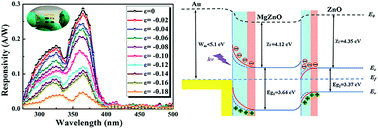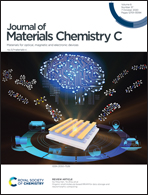Performance modulation of a MgZnO/ZnO heterojunction flexible UV photodetector by the piezophototronic effect†
Abstract
It is essential to modulate materials and their interfaces for excellent device performance. Here, an ultraviolet (UV) photodetector (PD) based on a flexible polyethylene terephthalate (PET)/ZnO/MgZnO heterojunction was successfully fabricated at room temperature. The piezophototronic effect was first used to modulate the transport behavior of the photogenerated carriers at the interface of the MgZnO/ZnO heterojunction. The responsivity increased from 0.23 to 0.95 A W−1 with the increase in external tensile strain from 0 to 0.18, an increase of ∼313%. Meanwhile, with the decrease in external compressive strain from 0 to −0.18, the responsivity decreased by ∼63%. This is owing to the modulation of the junction barrier and photogenerated carrier transport behavior at the MgZnO/ZnO junctions/interfaces via the piezophototronic effect. Moreover, the PD maintained excellent mechanical stability and reproducibility after different bending cycles 0/50/100/150/200 and excellent environmental stability after storage for over two months, which are beneficial for its practical applications. Furthermore, this study developed a method for modulating the performance of UV PDs, and showed that the piezophototronic effect has important theoretical significance and application prospect for the modulation of heterojunction interfaces.



 Please wait while we load your content...
Please wait while we load your content...